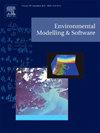A conceptual data modeling framework with four levels of abstraction for environmental information
IF 4.8
2区 环境科学与生态学
Q1 COMPUTER SCIENCE, INTERDISCIPLINARY APPLICATIONS
引用次数: 0
Abstract
Environmental data generated by observation infrastructures and models is widely heterogeneous in both structure and semantics. The design and implementation of an ad hoc data model for each new dataset is costly and creates barriers for data integration. On the other hand, designing a single data model that supports any kind of environmental data has shown to be a complex task, and the resulting tools do not provide the required efficiency. In this paper, a new data modeling framework is proposed that enables the reuse of generic structures among different application domains and specific applications. The framework considers four levels of abstraction for the data models. Levels 1 and 2 provide general data model structures for environmental data, based on those defined by the Observations and Measurements (O&M) standard of the Open Geospatial Consortium (OGC). Level 3 incorporates generic data models for different application areas, whereas specific application models are designed at Level 4, reusing structures of the previous levels. Various use cases were implemented to illustrate the capabilities of the framework. A performance evaluation using six datasets of three different use cases has shown that the query response times achieved over the structures of Level 4 are very good compared to both ad hoc models and to a direct implementation of O&M in a Sensor Observation Service (SOS) tool. A qualitative evaluation shows that the framework fulfills a collection of general requirements not supported by any other existing solution.
环境信息四级抽象概念数据模型框架
观测基础设施和模型产生的环境数据在结构和语义上都存在很大的差异。为每一个新数据集设计和实施一个临时数据模型的成本很高,而且会给数据集成造成障碍。另一方面,设计一个支持各种环境数据的单一数据模型已被证明是一项复杂的任务,而且由此产生的工具无法提供所需的效率。本文提出了一种新的数据建模框架,可在不同应用领域和特定应用之间重用通用结构。该框架考虑了数据模型的四个抽象层次。第 1 层和第 2 层以开放地理空间联盟(OGC)的观测与测量(O&M)标准为基础,提供了环境数据的通用数据模型结构。第 3 级包含不同应用领域的通用数据模型,而具体的应用模型则在第 4 级设计,重复使用前几级的结构。为说明该框架的能力,我们实施了各种用例。使用三个不同用例的六个数据集进行的性能评估表明,与临时模型和在传感器观测服务(SOS)工具中直接实施 O&M 相比,第 4 层结构的查询响应时间非常出色。定性评估显示,该框架满足了一系列其他现有解决方案无法支持的一般要求。
本文章由计算机程序翻译,如有差异,请以英文原文为准。
求助全文
约1分钟内获得全文
求助全文
来源期刊

Environmental Modelling & Software
工程技术-工程:环境
CiteScore
9.30
自引率
8.20%
发文量
241
审稿时长
60 days
期刊介绍:
Environmental Modelling & Software publishes contributions, in the form of research articles, reviews and short communications, on recent advances in environmental modelling and/or software. The aim is to improve our capacity to represent, understand, predict or manage the behaviour of environmental systems at all practical scales, and to communicate those improvements to a wide scientific and professional audience.
 求助内容:
求助内容: 应助结果提醒方式:
应助结果提醒方式:


